
views
- Boil a pot of water and cut the heat once it bubbles. Add your shirt to the pot, cover it, and let the shirt soak for 5-20 minutes.
- Or, throw your shirt in the washer with like colors and run a cycle on the hottest water setting.
- Air dry your shirt to keep it from shrinking more after you remove it from the hot water pot or washing machine. Machine dry on high to shrink it even more.
Shrinking with Boiling Water
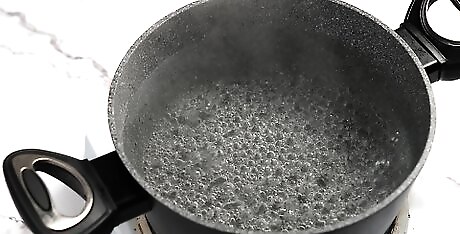
Boil a pot of water large enough to submerge the entire t-shirt. If you plan on shrinking multiple shirts at once, use an extra-large pot that can hold all of them. Submerging cotton in hot water will help the fibers contract and shrink (some cotton clothing is intentionally stretched a bit during manufacturing). If you want to shrink a graphic tee, skip ahead to Shrinking in the Washer & Dryer. The boiling method is more likely to damage the print than the washer. If your t-shirt has stains, pre-treat or remove them before shrinking (stains that haven’t been pre-treated will be permanently set in the fabric by the heat). Check your shirt’s tag to see if it’s pre-shrunk. If it is, then you’re likely stuck with the shirt’s current size (it may shrink a tiny bit, but it won’t be super noticeable). If you want to avoid the hassle of buying a shirt that's too big and shrinking it yourself, look for pre-shrunk garments when you shop.

Cut the heat once the water is boiling and place your shirt in the pot. For the maximum shrinkage (about 2 sizes smaller), add the shirt to the hot water right away—the warmer the water, the greater the shrinkage. A pure cotton garment will shrink about 20% at most. If you only want to to shrink the shirt a little bit, wait a few minutes before adding the shirt: To shrink roughly 1 to 2 sizes, put your shirt in right after you remove the pot from the heat. Too shrink roughly ½ to 1 size, wait 5 minutes before placing the shirt in the water. To shrink roughly ¼ to ½ size, wait 10-15 minutes before placing the shirt in the water.
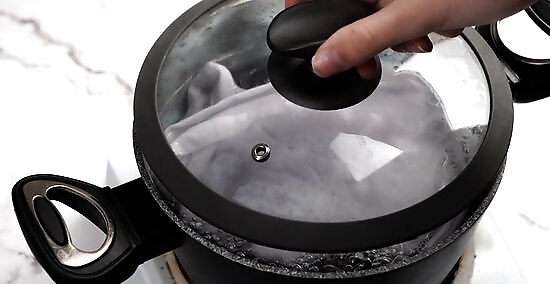
Cover the pot and let the shirt soak in the water for 5 to 20 minutes. The longer the shirt is exposed to the hot water, the more it will shrink. Let it soak for at least 5 minutes to get started, but no longer than 20 minutes total (the shirt will probably hit its maximum shrinkage by then). If you’re only shrinking it up to 1 size or less, pull the shirt out with tongs and inspect the size every couple of minutes (you may have to let it cool for a moment before handling it). If it needs to shrink further, put it back in the pot. If you’re not sure exactly how long to leave the shirt in, pull it out sooner rather than later. You can always repeat the process to shrink it further.
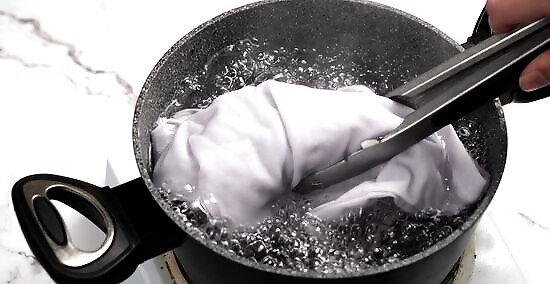
Remove the shirt from the pot with tongs, then drain the water. Take out the shirt slowly to avoid splashes that could scald your hands, and set it somewhere to cool for a few minutes, like a clean sink or countertop or in a different pot. Empty the pot of water (unless you have more cotton to shrink. Then, reheat the water and begin the process again).
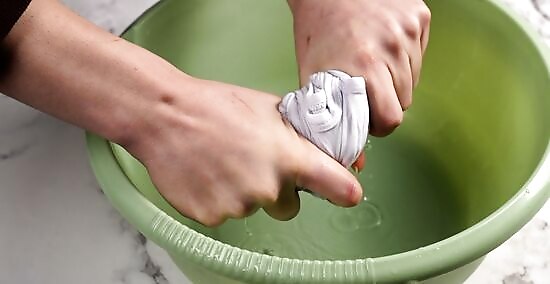
Squeeze the excess water out of the shirt once it’s cool and let it air dry. Gently roll and massage the shirt to wring out excess water (being careful not to stretch the fabric and undo the shrinking). Then, lay the shirt on a clean towel or drying rack to dry out. Air drying will preserve the shrinkage from the hot water without shrinking the shirt any further. To shrink the shirt even more (by up to 2 sizes compared to its original shape), use a dryer on high heat instead—the tumbling will cause it to shrink further. If the shirt needs to shrink more after it's dry, repeat the boiling process as many times as needed.
Shrinking in the Washer & Dryer
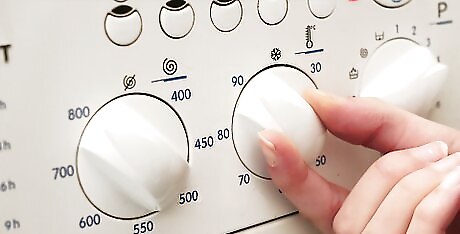
Wash your shirt in the washing machine with the hottest water setting. If you’re shrinking multiple t-shirts, wash them in batches of like colors (the hot water can cause color bleeding). If you’re shrinking a graphic tee, turn it inside out before you toss it in the wash. Check the shrinkage once the wash cycle is done. If the shirt looks small enough, air dry it. If it needs more shrinking, put it in the dryer. The hot water will force the cotton fibers to contract and shrink. The agitation of your shirt hitting the sides of the washer will help shrink them even further, too. Front-loading washers produce less agitation (and therefore slightly less shrinkage) than top-loading machines.
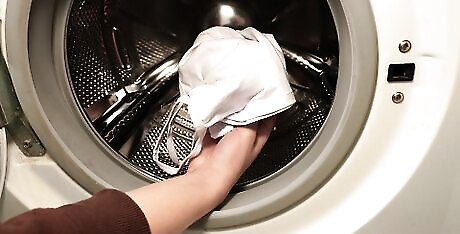
Transfer the shirt to the dryer and dry it on high heat. First, check your lint filter and remove any buildup—high heat plus a lot of dry lint can be a fire hazard. Then, toss your cotton t-shirt in and run it through the hottest dry cycle on your machine. If the shirt is vintage or a graphic tee, use medium heat to avoid cracking or melting the print (or air dry it to be extra safe). If your shirt only needs a little more shrinkage, pull it out of the dryer every couple of minutes to check on its progress. Once the dry cycle is complete, you’re done! Pull out your shirt and inspect your work. If it needs more shrinkage, run it through another hot washer-dryer cycle.

Dry your cotton t-shirts on medium heat in the future to prevent damage. High heat and tumbling may cause your shirt to shrink even more later, so unless you want an extra-tiny shirt, dry it on a lower heat setting next time you wash it. Repeated hot drying can also wear out and crack the fibers of your shirt, reducing the fabric’s strength by up to 25%. Dark-colored shirts may fade or look “powdery” because the heat and tumbling raises microscopically small fibers that diffuse the color.

Rock your newly fitted cotton t-shirt. There are tons of ways to make a fitted cotton t-shirt look effortlessly cool. Try styling it with a pair of slim-fit jeans for a casual look, or throwing a blazer over it for a more elevated ‘fit (keep the jeans or try a matching blazer-and-pants combo). When it comes to t-shirts, there’s no wrong way to wear them!


















Comments
0 comment